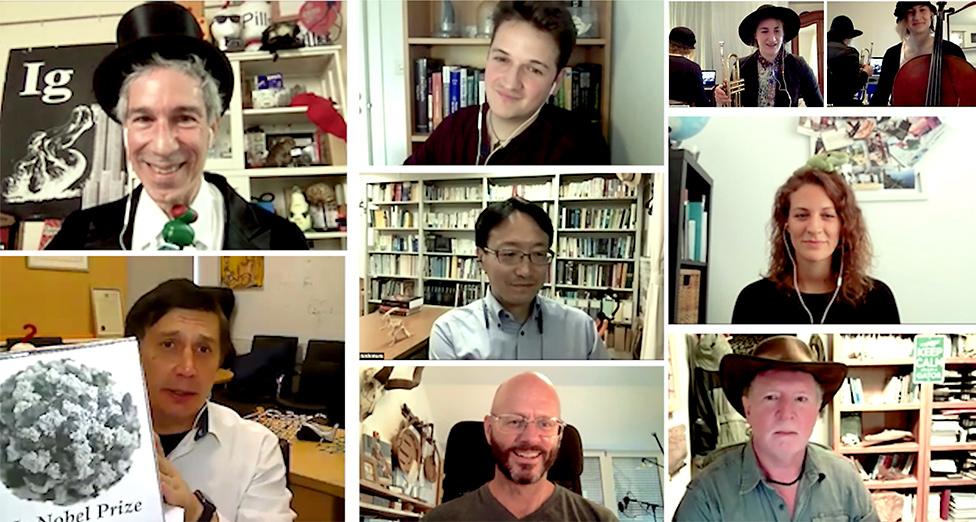Alligator on gas snaps up Ig Nobel prize
- Published
Alligator bellows: The first pair of sounds are in ambient air; the second pair are in heliox
Have you heard the one about the alligator that performed the party trick of breathing in helium so it could talk in a funny voice?
It's not that hilarious but then you'd be careful never to smile at a crocodilian.
Stephan Reber and colleagues performed the experiment to try to understand how alligators might communicate.
It was a serious piece of research but its slightly comedic aspects have just won the team an Ig Nobel Prize.
Ten such awards were handed out on Thursday by the science humour magazine Annals of Improbable Research, external.
The annual Igs are intended as a bit of a spoof on the more sober Nobel science prizes.
Other 2020 winners included the team that devised a method to identify narcissists by examining their eyebrows; and the group that wanted to see what happened when earthworms were vibrated at high frequency.
All this kind of stuff sounds daft, but when you dig a little deeper you realise much of the research lauded by the Ig Nobels is actually intended to tackle real-world problems and gets published in peer-reviewed, scholarly journals.

A real Nobel Laureate, Andre Geim (bottom-left), prepares to hand the Ig Nobel Acoustics Prize to Stephan Reber (middle-top) and his team
Dr Reber told BBC News he was honoured to receive the Ig.
His team's study had attempted to show that crocodilians and other reptiles could advertise their body size through their vocalisations - something that mammals and birds can do when they call out.
"The resonances in your vocal tract sound lower overall if you're larger because it's a larger space in which the air can vibrate. We didn't know if reptiles actually had resonances. Frogs, amphibians, don't for example. So we needed a proof of concept that crocodilians actually have resonances," he explained.
This was achieved by putting an alligator in an enclosed tank that could be filled alternately with normal air and a supply of oxygen and helium (heliox). The vibrations of the vocal tissues don't change but the noise the animals are able to make will, because the speed of sound is different in the different gas mixtures.
The analysis of the frequency spectrum confirmed alligators' body size does indeed correlate with the resonances they produce. "Although whether the animals can pick up on these cues, I haven't tested," the Lund University, Sweden, researcher said.
This is the 30th year the Ig Nobels have been presented.
Their usual home is the Sanders Theatre at Harvard University in Cambridge, Massachusetts, US; and the event is always a riotous affair that involves lots of paper plane throwing and a small girl who shouts "boring" at anyone who talks for too long.
But the Covid-19 crisis forced this year's ceremony online.
Even so, some traditions were maintained, like the involvement of real Nobel Laureates. Dr Reber's team was presented with its Ig by Andre Geim, the UK-based researcher who won the Physics Nobel in 2010 for his work on graphene.
The Prof is something of a superstar having also won an Ig earlier in his career for levitating frogs.

Here's a full list of the 2020 Ig Nobel winners. Each winning team was given a cash prize - of a 10 trillion dollar bill from Zimbabwe.
For Acoustics: Stephan Reber, Takeshi Nishimura, Judith Janisch, Mark Robertson, and Tecumseh Fitch, for inducing a female Chinese alligator to bellow in an airtight chamber filled with helium-enriched air.
Psychology: Miranda Giacomin and Nicholas Rule, for devising a method to identify narcissists by examining their eyebrows.
Peace: The governments of India and Pakistan, for having their diplomats surreptitiously ring each other's doorbells in the middle of the night, and then run away before anyone had a chance to answer the door.
Physics: Ivan Maksymov and Andriy Pototsky, for determining, experimentally, what happens to the shape of a living earthworm when one vibrates the earthworm at high frequency.
Economics: Christopher Watkins, Juan David Leongómez, Jeanne Bovet, Agnieszka Żelaźniewicz, Max Korbmacher, Marco Antônio Corrêa Varella, Ana Maria Fernandez, Danielle Wagstaff, and Samuela Bolgan, for trying to quantify the relationship between different countries' national income inequality and the average amount of mouth-to-mouth kissing.
Management: Xi Guang-An, Mo Tian-Xiang, Yang Kang-Sheng, Yang Guang-Sheng, and Ling Xian Si - five professional hitmen in Guangxi, China, who subcontracted a murder one to the other with none of them in the end actually carrying out the crime.
Entomology: Richard Vetter, for collecting evidence that many entomologists (scientists who study insects) are afraid of spiders, which are not insects.
Medicine: Nienke Vulink, Damiaan Denys, and Arnoud van Loon, for diagnosing a long-unrecognized medical condition: Misophonia, the distress at hearing other people make chewing sounds.
Medical Education: Jair Bolsonaro of Brazil, Boris Johnson of the United Kingdom, Narendra Modi of India, Andrés Manuel López Obrador of Mexico, Alexander Lukashenko of Belarus, Donald Trump of the USA, Recep Tayyip Erdogan of Turkey, Vladimir Putin of Russia, and Gurbanguly Berdimuhamedow of Turkmenistan, for using the Covid-19 viral pandemic to teach the world that politicians can have a more immediate effect on life and death than scientists and doctors can.
Materials Science: Metin Eren, Michelle Bebber, James Norris, Alyssa Perrone, Ashley Rutkoski, Michael Wilson, and Mary Ann Raghanti, for showing that knives manufactured from frozen human faeces do not work well.
Jonathan.Amos-INTERNET@bbc.co.uk, external and follow me on Twitter: @BBCAmos, external